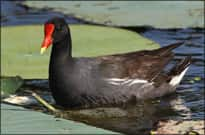Arkansas GFC: Snipe, Rail, Gallinule, Moorhen, Woodcock Hunting is Real
OutdoorHub 07.25.12

If you read all the way to the bottom of news articles about setting of early migratory bird hunting seasons, you saw those names. Woodcock, snipe, rail, gallinule, moorhen.
What are these, and is hunting for them for real?
Yes, indeed. You can hunt them – if you know what they are and can identify them and find them. Some Arkansans do, although these hunters could hold a convention on your back deck.
These are marsh birds, sometimes labeled shore birds. Woodcocks tend to hang out more in upland areas, but still they are classified as marsh birds.
All these species come to Arkansas in late fall and early winter, and all are highly secretive, a major factor in their being little known to outdoors people in the state. A common characteristic for all these five species of marsh birds is a long slender bill which is used for probing into mud for various food items.
In a number of states to the north and east, woodcock hunting is a major activity. Enthusiasts speak of their woodcock shotguns, woodcock boots, woodcock dogs. But the other four species listed in Arkansas hunting seasons aren’t as well known.
Except for woodcock and snipe, the daily bag limits are generous. But who has acquired 25 rails in a day in the field? Or 15 purple gallinules or 15 moorhens?
Another common characteristic of all five marsh bird species is they are good to eat, although there isn’t a lot of meat on each of them. The meat is dark and good tasting when properly prepared. This includes using moist cooking methods to avoid drying out the meat. “About like cooking and eating dove,” one Arkansas hunter described it.
The marsh bird seasons and daily limits this year are:
- Rail, Sept. 8-Nov. 16, limit 25.
- Woodcock, Nov. 3-Dec. 17, limit three.
- Common snipe, Nov. 1-Feb. 15, limit eight.
- Purple gallinule, Sept. 1-Nov. 9, limit 15.
- Common moorhen, Sept. 1-Nov. 9, limit 15.
A suggestion for finding one or more of the species is to scout lowlands close to major waterways. Along the Arkansas River is an example. You need to identify them before hunting. A bird field guide will help. In many cases, your first sight of a marsh bird will be when it flushes virtually from under your feet.
Most marsh bird hunters use shotguns with improved cylinder chokes and small size shot like No. 7 ½ or No. 8.

